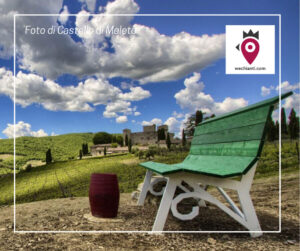Articolo disponibile anche in: Italian
The legend that circulates since the Dark ages, supported by a continuous use for centuries, seems to have more than a reality ground, except for one thing: the legendary Chianti Classico Rooster symbol is actually white.
The news broke through from a collection of letters of the fifteenth century, found last year in a private archive and donated to the University of Eastern Molise, where it has been studied by a team of paleographers.
The exchange leads to retrace the evolution of relations between the two gentlemen, Ciacco di Giacomo di Roddi and Ganismondo degli Albefrighi, whose possessions were contiguous, one under Siena and the other under the Florentine Republic.
Ganismondo writes to his ” castle – neighbor” decrying the constant raids that plagued those frontline territories and hoping for a quick fix of the gonfaloniere of Florence Pier Moscerini.
Ciacco Roddi responds by announcing a duel between noblemen, such as peaceful conflict resolution. The next missive tells the astonishment and anger of the Florentine man in front of the outcome of the challenge. It tells in detail the agreements between the two republics:
It was agreed that two knights would depart from their respective cities and fix the boundary point at where they met. Departure was to be at dawn and the signal to ride given by rooster crow, quite logical for an epoch when daily routines were paced by natural rhythm.
In preparing for the event, more importance was given to the choice of the rooster than of the rider or the horse. The Sieneses chose a white rooster, and the Florentines a black one, which they kept in a small, dark chicken coop and practically starved for so many days that it was desperate.
On the fatal day, as soon as it was freed from the coop the rooster began to crow, although dawn was still far away. His loud crowing allowed the Florentine knight to set off posthaste and much ahead of his Sienese counterpart who had to wait for daybreak for his rooster to crow.
And since the Florentine horseman had such a head start he met up with the Sienese knight at Fonterutoli, a mere 12 kilometers from the latter’s departure point.
The Sienese Ciacco answer is succinct: so did decide the fate, and seals the paper with a stamp bearing the Gallo Bianco, now a metaphor for the victory.
The scholars who have published the discovery on Tuscian Paleography Quarterly, a prestigious scientific journal, are analyzing the thumbnails of a manuscript of uncertain date that shows the image of a knight with a banner depicting a white rooster that comes from Florence Porta al Prato .
This of course upsets centuries of traditional use of the Gallo Nero as a symbol of the Chianti Classico region, and the Consortium states that the procedures to introduce the new brand are already under way.
It will depicts a White Rooster, according to the new historical reality emerged. In fact, the Gallo Nero appears on every bottle of Chianti Classico wine, on the neck or rear label, as well as on the territory in countless ways, by 2-meter tall sculptures standing in all municipalities of the territory, the name of a bicycle race, the Granfondo of Gallo Nero, and over time it has been the subject of works of art as the allegori adel Chianti by Giorgi Vasari on the ceiling of the Salone dei 500 in the Palazzo Vecchio, it has been the image of many important initiatives, such as the Giro d’Italia 2016 with Chianti Classico stage. In short, a real heritage of this area, known throughout the world.
P.S.: April Fool’s Day – the Rooster is Black! Here the true story


